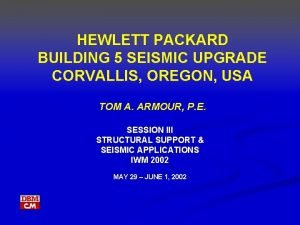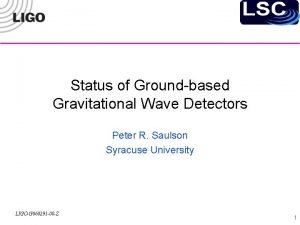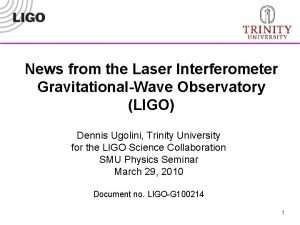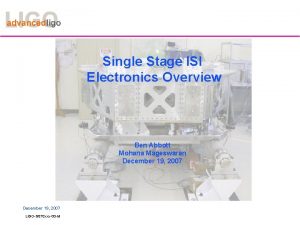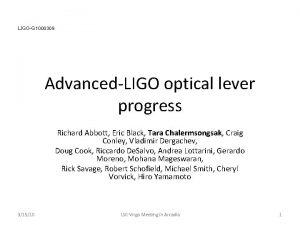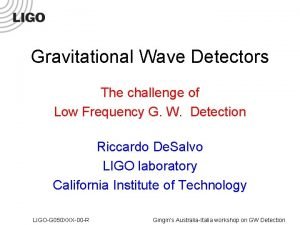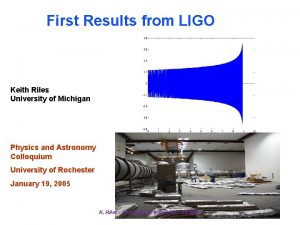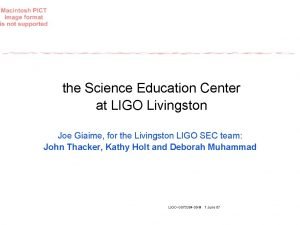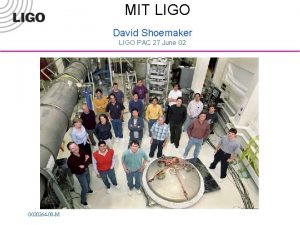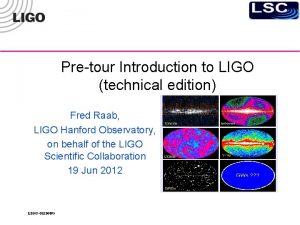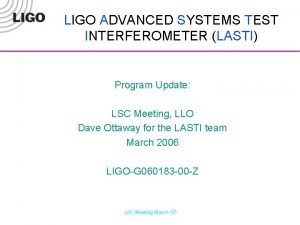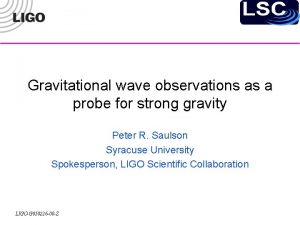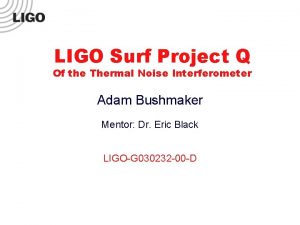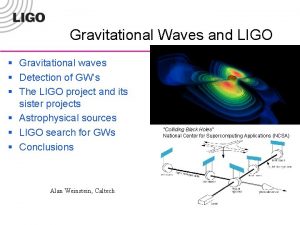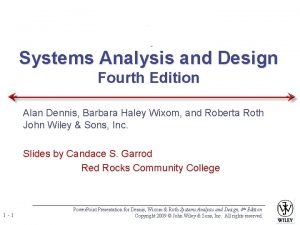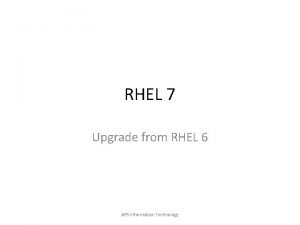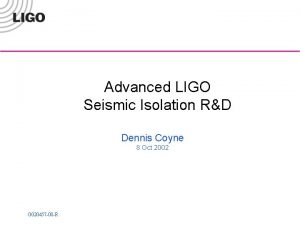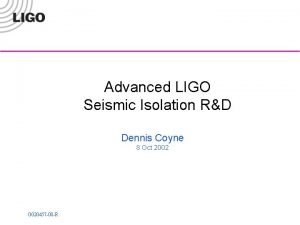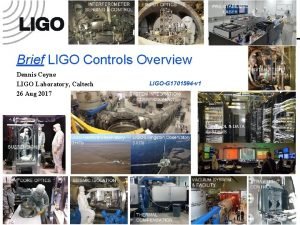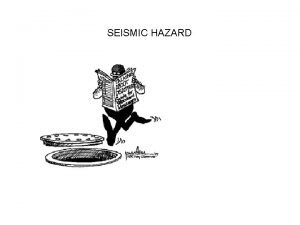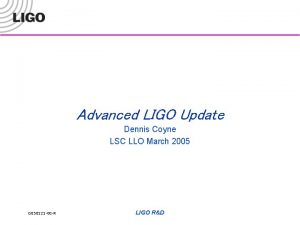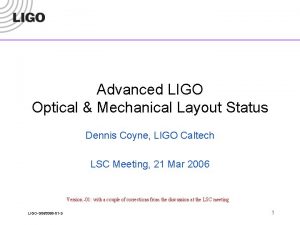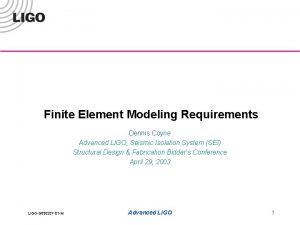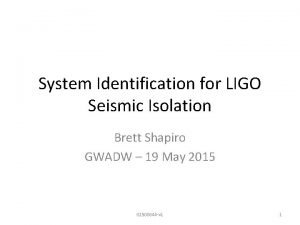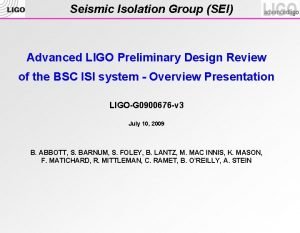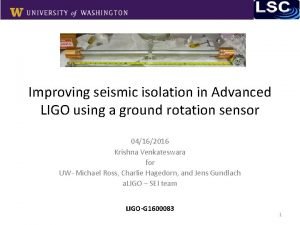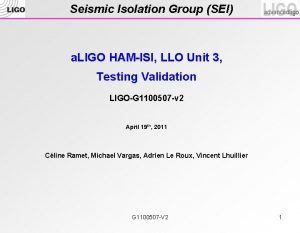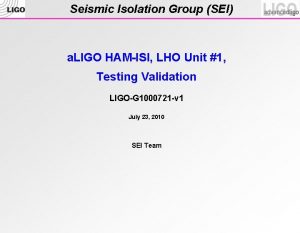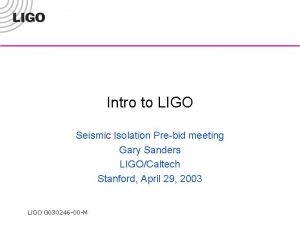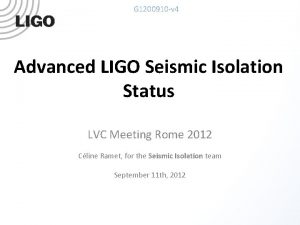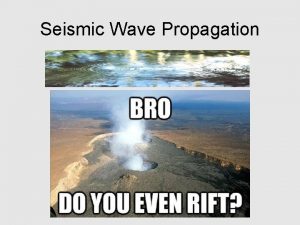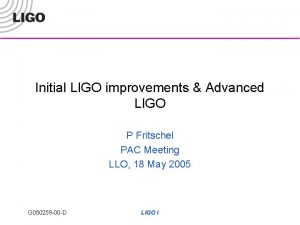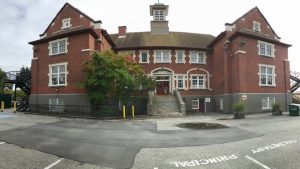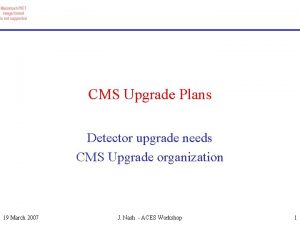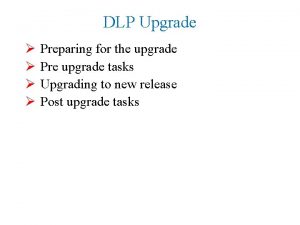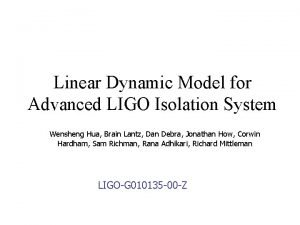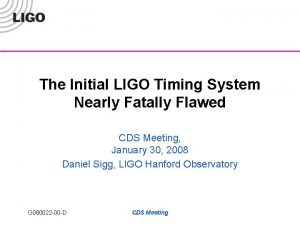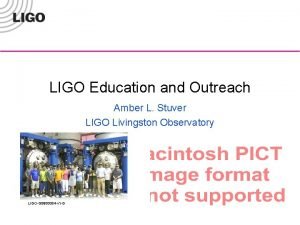Initial LIGO Seismic Isolation System Upgrade Dennis Coyne






























- Slides: 30

Initial LIGO Seismic Isolation System Upgrade Dennis Coyne LIGO Seminar March 29, 2002 LIGO-G 020147 -00 -M 1

Problem l Ground motion at LLO with the initial LIGO seismic isolation system makes it impossible to hold the interferometers locked reliably during the day » Steady-state ambient noise is higher due to anthropomorphic sources » Transients, particularly from logging l Wind induced seismic noise at LHO: » exceeds locking threshold at ~25 mph, or 4% of the time » Expect up-conversion is a problem at significantly lower wind speeds & a large fraction of the time l Upgrade is required to allow both reliable locking and to allow better noise performance while locked » Need 90% duty cycle & lock durations > 40 hours » Need to reduce noise in the control band (< 40 Hz) to permit a smaller suspension actuator authority & lower noise » Suppression in the 1 -3 Hz band is most important due to excitation of the lower stack modes (Q ~ 30) LIGO-G 020147 -00 -M 2

Typical Day/Night Seismic Noise Levels in the 1 -3 Hz Band LIGO-G 020147 -00 -M 3

Integral Histogram of the Peak Ground Velocity LIGO-G 020147 -00 -M 4

Up-conversion Example LIGO-G 020147 -00 -M 5

Initial Vibration Isolation Systems » » Reduce in-band seismic motion by 4 - 6 orders of magnitude Little or no attenuation below 10 Hz; amplification at stack mode resonances Large range actuation for initial alignment and drift compensation Quiet actuation to correct for Earth tides and microseism at 0. 15 Hz during observation HAM Chamber LIGO-G 020147 -00 -M BSC Chamber 6

Seismic Isolation – Springs and Masses damped spring cross section LIGO-G 020147 -00 -M 7

Seismic System Performance HAM stack in air BSC stack in vacuum 102 100 10 -2 10 -6 10 -4 Horizontal 10 -6 10 -8 Vertical LIGO-G 020147 -00 -M 10 -10 8

Active External Pre-Isolation (EPI) & Active Internal Damping (AID) LIGO-G 020147 -00 -M 9

Alternate Approaches LIGO-G 020147 -00 -M 10

EPI Requirements l Net Noise at the base of the stack: » » Maintain present drift stability: 1 month, 10 microns pk-pk Alignment precision for lock: 100 seconds, 1 micron pk-pk Microseismic peak: 0. 16 Hz, 4 e-7 m/√Hz Integrated rms level similar to Hanford at night & consistent with the technology: l l 1 Hz 10 Hz 1 e-9 m/√Hz 4 e-10 m/√Hz » Suspension vertical bounce mode: 15 Hz, 2 e-10 m/√Hz » No degradation in current in-band isolation: l l l 30 Hz > 50 Hz 6 e-11 m/√Hz 2 e-11 m/√Hz Dynamic Range: 10 mm p-p static alignment, 300 microns p-p LIGO-G 020147 -00 -M 11

AID Requirements l Noise contribution in the GW band must be < 1/10 of the Science Requirements Document (SRD), or at the optics table: » BSC: l l Horizontal: 1. 2 e-13 m/√Hz at 20 Hz, 2. 5 e-17 m/√Hz at > 50 Hz Vertical: 5 e-13 m/√Hz at 20 Hz, 1 e-16 m/√Hz at > 50 Hz » HAM: l l l Horizontal: 4 e-12 m/√Hz at 20 Hz, 2. 5 e-16 m/√Hz at > 50 Hz Vertical: 2 e-11 m/√Hz at 20 Hz, 1 e-15 m/√Hz at > 50 Hz Damping to Q~3 on at least the 1. 2 and 2. 1 Hz BSC modes, with no ‘spillover’ in excess of 1. 5 x total rms LIGO-G 020147 -00 -M 12

2 DOF Pre-Isolation with the existing Fine Actuation System (FAS) l l l l Proof-of-principle test for external seismic isolation layer. Existing fine actuators in end (and mid)station, driven in pairs, can move stack base in beam direction and in yaw. GS-13 seismometers placed on crossbeams above FAS Provide inertial error signals for 2, 1 -DOF SISO servos. d. Space signal processing board and software in PC allows rapid controller/compensation development and provides GUI control panel Resonant gain added at two troublesome stack modes (1. 2 and 2. 1 Hz), allowing factor of a few more gain there without destabilizing overall servo. This resulted in about a factor of 7 decrease in motion seen by the test mass at the stack modes. LIGO-G 020147 -00 -M 13

2 DOF Pre-Isolation with the existing Fine Actuation System (FAS) LIGO-G 020147 -00 -M 14

2 DOF Pre-Isolation with the existing Fine Actuation System (FAS) LIGO-G 020147 -00 -M 15

2 DOF Pre-Isolation with the existing Fine Actuation System (FAS) LIGO-G 020147 -00 -M 16

Planned Initial Detector Modifications BSC HAM LIGO-G 020147 -00 -M 17

Spring/Actuator Assembly with the Electro-Magnetic Actuator Point of attachment to the seismic external crossbeams Horizontal electromagnetic actuator Seismic stack static load carrying springs Horizontal and Vertical geophones Vertical electromagnetic actuator Seismic support pier LIGO-G 020147 -00 -M 18

The Quiet Hydraulic Actuator Displacement Sensor Bellows Servo Valve Current Design LIGO-G 020147 -00 -M Actuation Plate Current Design Implemented On LIGO Pier 19

Differential Bellows for Quiet Actuator 1) Pump 2) Differential Flapper Valve 3) Bellows Supply 4) Differential Bellows 5) Actuation Plate LIGO-G 020147 -00 -M 20

Conditioning a Pressure Source Active and Passive Suppression of Pressure Fluctuations Pressure Sensor Compensator Accumulator Pump Servo Valve Reservoir LIGO-G 020147 -00 -M 21

Pressure Noise at the Actuator LIGO-G 020147 -00 -M 22

The Test Platform at Stanford Vertical Actuator Displacement Sensor Seismometer (Geotech S-13) Seismometer (Streckeisen STS-2) 800 lb Test Mass Vertical Actuator Horizontal Actuator LIGO-G 020147 -00 -M 23

Sensor Correction Compensator zm - zg + zg STS 2 Filter LIGO-G 020147 -00 -M + External Alignment Input 24

Vertical Isolation LIGO-G 020147 -00 -M 25

Horizontal Isolation LIGO-G 020147 -00 -M 26

Active Internal Damping System Layout LIGO-G 020147 -00 -M 27

Active Internal Damping (AID) Prototyping LVDT (left) & Constant force Actuator horizontal doublet LIGO-G 020147 -00 -M HAM Prototype 28

LASTI Full Scale Prototype Testing l l Stand-alone subsystem testing is underway for each subsystem The AID & HEPI subsystems will be tested on a BSC isolation stack/chamber at the LASTI facility (MIT) starting in June/July The MEPI subsystem will be tested at the same time on a LASTI HAM stack/chamber Initially all controls will be performed with D-Space controllers before integrating the systems into the LIGO Epics Supervisory Control & DAQ systems LIGO-G 020147 -00 -M 29

Summary l l Testing and analyses to date all look promising An interim solution which should enable LLO to lock reliably between the Science 1 and Science 2 runs is being installed (2 DOF pre-isolation with the fine actuation system) Seismic retrofit with an active pre-isolation system and an active internal damping system is planned for after the Science 2 run, in Jan 2003 A Design Review will be held in 2 weeks » April 12, 9: 00 am PT » Documentation is nearly ready for release LIGO-G 020147 -00 -M 30
 Hewlett packard oregon
Hewlett packard oregon Seismic isolation
Seismic isolation Seismic isolation
Seismic isolation Coyne first aid
Coyne first aid Ann coyne suffolk university
Ann coyne suffolk university David coyne ndis
David coyne ndis Coyne pr logo
Coyne pr logo Ben abbott ligo
Ben abbott ligo Richard abbott ligo
Richard abbott ligo Ligo challenge xxx
Ligo challenge xxx Ligo detections
Ligo detections Ligo science education center
Ligo science education center Ligo science education center
Ligo science education center David shoemaker ligo
David shoemaker ligo Ligo
Ligo Ligo
Ligo Ligo
Ligo Caltech ligo surf
Caltech ligo surf Ligo
Ligo Systems analysis and design dennis
Systems analysis and design dennis System analysis and design alan dennis
System analysis and design alan dennis Alan dennis system analysis design
Alan dennis system analysis design Wholesale loose seismic cable
Wholesale loose seismic cable Upgrade 2003 to 2008
Upgrade 2003 to 2008 Database upgrade project plan
Database upgrade project plan Visio 2010 trial
Visio 2010 trial Upgrade image quality
Upgrade image quality Upgrade rhel 6 to 7
Upgrade rhel 6 to 7 Remedy upgrade
Remedy upgrade Social media identifier
Social media identifier Cisco router technical support
Cisco router technical support
